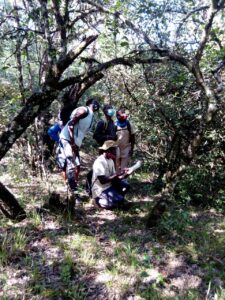Dawn approaches, and Mount Kenya is preparing to wake up. The African sun, to the east, is on the rise, casting its rays over Kenya’s tallest mountain. Members of the Mount Kenya Biodiversity Conservation Group are on a bird-watching adventure. Their destination is Gathioryu forest, a block of the Mount Kenya forest.
Armed with binoculars, field guides, water and snacks, they hit the road. As they say, birding is mind therapy and draws one closer to nature. The group of enthusiastic birders is out to quench its thirst for a thrilling encounter with birds.

Sweet bird melodies fill the cold morning air. Sunbirds, bee-eaters, warblers, doves and weavers take turns in the morning dawn chorus. Here, birds are more heard than seen. Bird calls are key identification features. Apart from understorey dwellers, the majority spend most of their time in the high canopies.
We tick boxes on our bird checklist. Variable Sunbirds and Cinnamon-chested Bee-eaters are the first entries on the list. The diversity of birds here is broad, making it one of the top hotspots in the central Kenya region. The forest is home to other animals too.
Olive Baboons cling on tree trunks as they grab insects hiding in the bark. Their young ones playfully hop from tree to tree, spilling dry leaves on our heads. Black and White Colobus Monkeys lazily fed on leaves and seedpods, their long graceful tails dangling from the branches, evidently not bothered by our presence.
Mounds of elephant droppings cover the forest trail. It is fascinating to witness life emerge from relatively older droppings: seedlings sprouting, dung beetles taking off and landing. Francolins have scattered the dung profusely in their quest to hunt for insects to eat. The droppings are indeed magnets attracting an array of organisms.
As we proceed, a member of our troop recalls some information on elephants. An adult elephant can eat up to 200kgs of vegetative matter on a single day and equally excrete large amounts of droppings. These droppings contain seeds and nutrients. The seeds will germinate and grow, feeding on nutrients supplied by the droppings. Elephant calves will eventually wean on these plants to keep the cycle going. Quite a revelation!
More unravels. The shy and elusive bushbucks hop around and venture deep onto thickets, perhaps to conceal their identity from us. Our trail weaves deeper with every corner we take, opening up a new chapter of encounters to see and learn.
Our four-hour walk in the forest comes to an end with 30 bird species recorded. It’s been an exciting experience interacting with our natural world.
